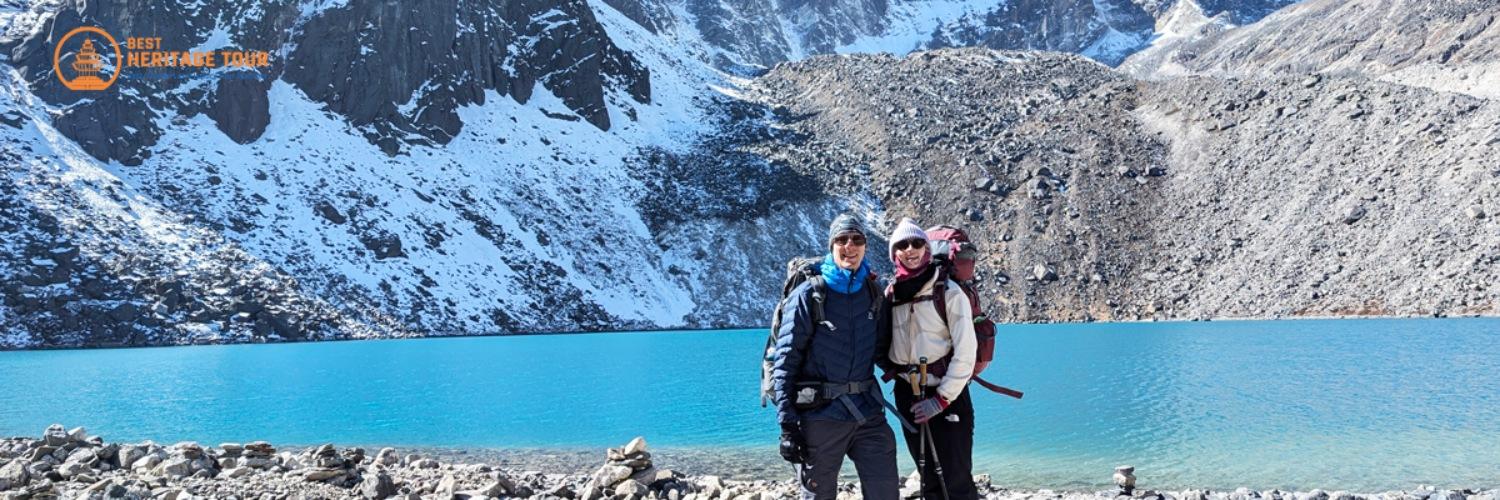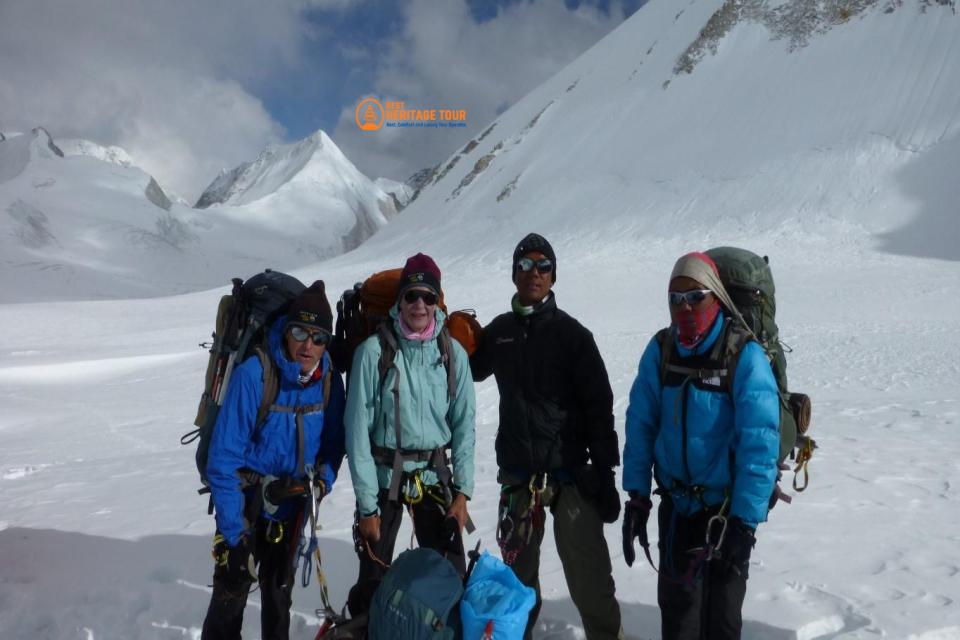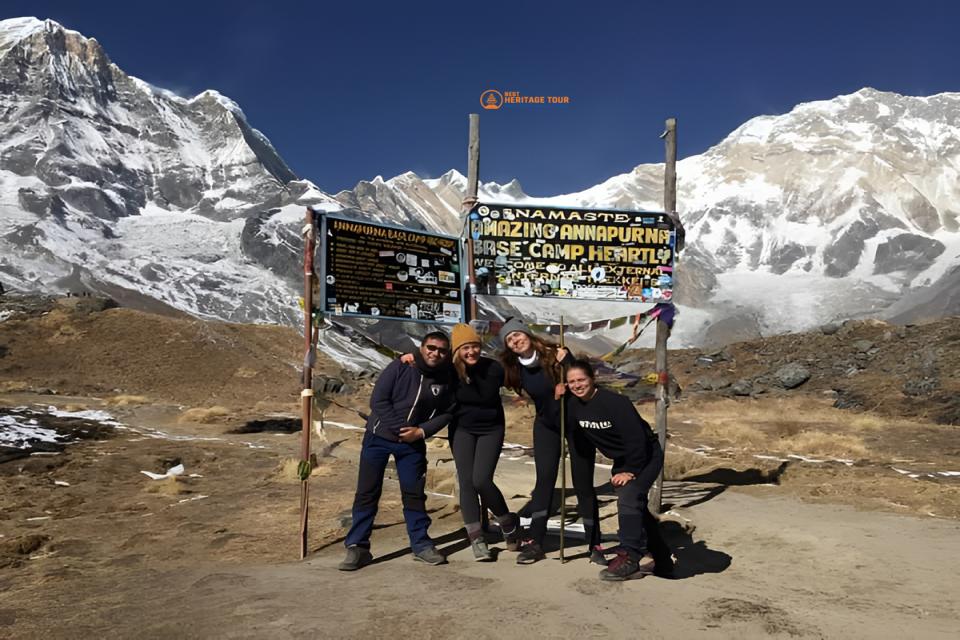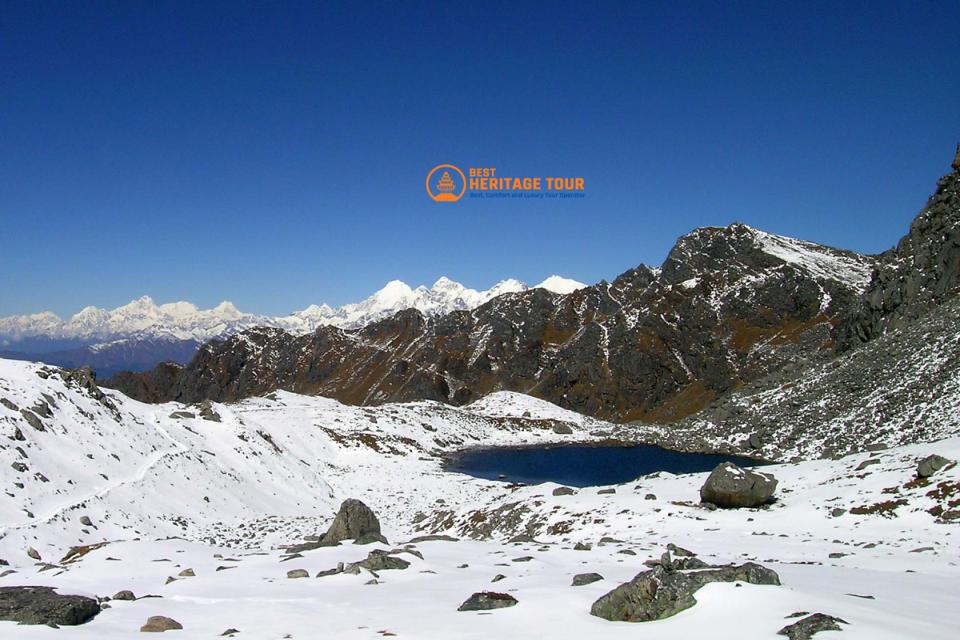If you're dreaming of trekking through the towering peaks and icy landscapes of the Himalayas, glacier treks in Nepal offer some of the most exhilarating and unforgettable adventures on Earth. From world-renowned routes like Everest Base Camp to remote wilderness trails like Makalu Base Camp, these treks blend epic glacial vistas with rich cultural encounters, making them a must for any serious adventurer. In this comprehensive guide, we’ll uncover the best glacier treks in Nepal for the 2025/2026 trekking season, plus when to go, what to pack, how to prepare, and how to trek responsibly.
Why Glacier Treks in Nepal Are Worth the Challenge
Glacier treks in Nepal combine breathtaking Himalayan scenery, cultural immersion, and raw adventure. These high-altitude routes offer rare access to Nepal’s most stunning glaciers and remote mountain landscapes.
1. The Unique Allure of Himalayan Glaciers
Nepal is home to some of the world’s most dramatic and ancient glaciers, nestled high in the heart of the Himalayas. Glacier treks offer a raw, awe-inspiring glimpse into a fragile environment shaped by millennia of ice and rock. Whether you're navigating the Khumbu Glacier below Everest or exploring the Langtang Glacier's rugged terrain, each glacier offers a rare combination of natural power and pristine beauty.
2. Adventure Meets Pristine Natural Beauty
Unlike ordinary mountain hikes, glacier treks combine high-altitude challenges with ethereal landscapes, icefalls, crevasses, alpine lakes, and towering snow-covered peaks. These landscapes aren’t just beautiful, they’re otherworldly. Each step on a glacial trail takes you deeper into a realm where nature reigns supreme and the silence is broken only by the crunch of your boots on ice.
3. Opportunities for Cultural Encounters En Route
Beyond the scenery, glacier treks in Nepal are also deeply cultural. Along many routes, you’ll pass through traditional villages inhabited by Sherpa, Tamang, Gurung, and other indigenous communities. Visiting ancient monasteries, sharing tea with locals, and learning about Himalayan lifestyles adds a meaningful human layer to your trek.
4. Ideal for Thrill-Seekers and Photographers Alike
Whether you're chasing the adrenaline of high passes or looking to capture dramatic glacier-fed landscapes through your lens, glacier treks are incredibly rewarding. From sunrise shots of frozen valleys to panoramic views of snow-capped giants, these journeys are a photographer’s dream.
Best Seasons for Glacier Treks in Nepal
Choosing the right season for glacier trekking in Nepal is essential for safety and breathtaking views. Spring and autumn offer the best weather, trail conditions, and visibility, while monsoon and winter pose serious trekking challenges.
1. Spring (March to May): Blooming Trails and Clear Skies
Spring is one of the most popular seasons for glacier trekking in Nepal. As the snow melts, rhododendron forests burst into bloom, and clear blue skies offer unobstructed views of the Himalayas. Trails are less icy than in winter but still feature stunning glacial features and snowfields at higher elevations.
2. Autumn (September to November): Best Visibility and Trail Conditions
Autumn is widely considered the best time for glacier treks. Post-monsoon skies are crisp and clear, with ideal conditions for photography and safe trekking. Trail infrastructure is in full swing, and many teahouses are open and well-stocked. Visibility of glaciers and peaks is usually at its best during this season.
3. Avoiding Monsoon and Winter Hazards
Monsoon (June to August) brings heavy rains, slippery trails, and cloud-covered mountains, not ideal for glacier treks. Winter (December to February), while visually stunning with snow-blanketed landscapes, poses hazards like closed passes, sub-zero temperatures, and increased avalanche risk.
4. Weather Considerations at High Altitudes
High-altitude glacier treks involve unpredictable weather. Storms can roll in quickly, temperatures fluctuate wildly between day and night, and even in spring or autumn, snow can appear above 4,500 meters. Always check weather forecasts and be flexible with your itinerary.
Must-Do Glacier Treks for 2025/2026
Explore Nepal’s top glacier treks for 2025/2026, breathtaking routes like Everest Base Camp, Manaslu Circuit, and Tilicho Lake. These high-altitude adventures offer stunning glaciers, rugged trails, and rich Himalayan culture for an unforgettable trekking experience.
1. Everest Base Camp and Khumbu Glacier
One of the most iconic glacier treks in the world, the Everest Base Camp (EBC) trek takes you deep into the Khumbu region, home to towering peaks and the formidable Khumbu Glacier. The journey offers surreal encounters with glacial landscapes, including the famed Khumbu Icefall.
Highlights:
- Kala Patthar viewpoint (5,545 m) for sunrise over Everest
- Walking along the edge of the Khumbu Glacier
- Exploring Sherpa villages like Namche Bazaar and Tengboche
- Visiting Everest Base Camp itself (5,364 m)
2. Manaslu Circuit and Larkya Glacier
Less crowded and more remote, the Manaslu Circuit Trek is a hidden gem. The highlight is crossing the Larkya La Pass (5,160 m), where you’ll be rewarded with jaw-dropping views of the Larkya Glacier and surrounding peaks.
Highlights:
- Culturally rich villages like Samagaun and Samdo
- Views of Manaslu (8,163 m), the world’s 8th highest peak
- Wild, remote trails with fewer trekkers
- Close-up views of the glacier from the Larkya Base
3. Annapurna Circuit with Tilicho Lake Glacier Extension
The Annapurna Circuit Trek is legendary, but adding a detour to Tilicho Lake (4,919 m) and its nearby glacier makes it even more spectacular. The lake sits beneath glaciated peaks and receives meltwater from surrounding ice masses.
Highlights:
- Thorong La Pass (5,416 m), one of the highest trekking passes in the world
- Tilicho Lake, one of the highest glacial lakes on Earth
- Diverse ecosystems from subtropical forests to alpine deserts
- Incredible glacial scenery along Tilicho Valley
4. Langtang Valley and Langtang Glacier
Just a day's drive from Kathmandu, the Langtang Valley Trek is a relatively short yet rewarding glacier trek. The upper valley offers fantastic views of the Langtang Glacier, especially near Kyanjin Gompa, a traditional Buddhist monastery village.
Highlights:
- Authentic Tamang culture and ancient monasteries
- Easy access and fewer trekkers
- Stunning glacier and peak views without the extreme altitude
- Optional hike to Tserko Ri (4,984 m) for panoramic glacier views
5. Makalu Base Camp and Barun Glacier
For seasoned trekkers, the Makalu Base Camp Trek is a raw, challenging adventure. It leads to the base of Makalu (8,485 m), the world’s fifth-highest mountain, and offers surreal encounters with the Barun Glacier and wilderness of the Barun Valley.
Highlights:
- Remote landscapes with dramatic glaciers and ridgelines
- Biodiversity hotspot inside Makalu-Barun National Park
- Panoramic views of Everest, Lhotse, and Chamlang
- A true expedition feel, best for those with experience
Difficulty Levels and Trekking Requirements
Challenging glacier treks in Nepal require strong fitness, high-altitude experience, and careful acclimatization to safely navigate tough terrain. For remote routes like Manaslu and Makalu, guides and porters are highly advised.
1. Altitude, Distance, and Physical Demands
Glacier treks in Nepal are typically high-altitude expeditions, often reaching elevations above 4,500 meters (14,764 feet). These treks challenge even seasoned hikers, combining steep ascents, long walking hours (6-9 hours a day), and unpredictable weather. Glacier terrain, often icy, rocky, and uneven, adds an additional layer of difficulty. Treks like Makalu Base Camp or Manaslu Circuit are particularly strenuous and demand prior experience, while Langtang Valley may suit moderately fit adventurers.
2. Recommended Experience Level and Fitness
For glacier treks, having prior experience in high-altitude hiking is highly recommended. You should be:
- Comfortable walking for 6+ hours a day for consecutive days
- Acclimatized to altitudes above 3,500 m
- Free from serious cardiovascular or respiratory conditions
- Mentally prepared for physical hardship and isolation
If you’re a first-timer, Everest Base Camp or Langtang Valley may be manageable with adequate training and preparation. More technical or remote treks like Makalu Base Camp are best left for experienced trekkers.
3. Importance of Proper Acclimatization
One of the most critical aspects of glacier trekking is proper acclimatization. Ascending too quickly can lead to Acute Mountain Sickness (AMS), which may develop into life-threatening conditions like HAPE or HACE. Standard acclimatization strategies include:
- Following the “climb high, sleep low” principle
- Including rest days (e.g., at Namche Bazaar or Samagaun)
- Staying hydrated and eating well
- Avoiding alcohol and smoking
4. Guide and Porter Recommendations
Hiring a licensed guide is highly recommended, not just for navigation and safety, but also for cultural enrichment and logistical support. Porters can ease your burden by carrying heavy gear, especially on longer treks like the Annapurna Circuit or Manaslu Circuit.
Many treks (like Manaslu and Makalu) legally require at least two trekkers and a registered guide, as they pass through restricted regions.
Essential Permits and Logistics
Before trekking Nepal’s glacier routes, it’s vital to understand the required permits, trekking regulations, and transportation options. From Everest to Manaslu and Tilicho, each region has specific entry rules, fees, and access points. Whether trekking independently or with a guide, proper preparation ensures a safe, legal, and responsible Himalayan adventure.
1. Required Permits for Each Glacier Trek
Depending on the region, you’ll need different permits. Here’s a breakdown:
|
Trekking Route & Glacier |
Required Permits |
|---|---|
|
Everest Base Camp & Khumbu Glacier |
- Sagarmatha National Park Permit - Khumbu Pasang Lhamu Rural Municipality Permit |
|
Manaslu Circuit & Larkya Glacier |
- Manaslu Restricted Area Permit (RAP) - Manaslu Conservation Area Project (MCAP) - Annapurna Conservation Area Permit (ACAP) |
|
Annapurna Circuit & Tilicho Glacier |
- Annapurna Conservation Area Permit (ACAP) - TIMS Card (Trekkers' Information Management System) |
|
Langtang Valley & Langtang Glacier |
- Langtang National Park Permit - TIMS Card |
|
Makalu Base Camp & Barun Glacier |
- Makalu-Barun National Park Permit - TIMS Card |
2. Entry Fees and Local Regulations for Trekking in Nepal (2025/2026)
Before embarking on a trek in Nepal, understanding permit costs and local regulations is essential. Fees vary by region and season, especially in restricted areas. Failure to comply with entry rules or carry proper documents may result in fines at checkpoints.
i. Trekking Permit Fees by Region and Type
|
Permit Type |
Fee (USD) |
|---|---|
|
National Park Entry Permit |
$22 - $25 per person (e.g., Sagarmatha, Langtang, Makalu-Barun) |
|
Conservation Area Permit (ACAP/MCAP) |
$22 - $25 per person |
|
Restricted Area Permit (e.g., Manaslu) |
$75 - $100 per person/week (varies by season) |
|
TIMS Card (if required) |
$15 - $20 per person (varies by trekking agency involvement) |
Note: SAARC nationals often receive discounted rates on most permits.
ii. Important Trekking Regulations
- Carry the following at all times while trekking:
- Original passport
- Recent passport-sized photos
- Printed or digital permit copies
- Fines may be issued at police or conservation checkpoints if permits are missing.
- Permit requirements vary between restricted, national park, and conservation areas.
- Always verify the latest fees and rules with your trekking agency or the Nepal Tourism Board before departure.
3. Transportation Options and Access Points
Getting to Nepal’s top trekking regions requires planning your transport carefully. Here are the main access points and transport methods for the Everest, Manaslu, Annapurna, Langtang, and Makalu regions.
- Everest Region: Fly from Kathmandu or Ramechhap to Lukla, the main gateway for Everest Base Camp treks.
- Manaslu Circuit: Drive to Soti Khola via Arughat, the common starting point for this remote trek.
- Annapurna Circuit: Begin your journey at Besisahar and finish near Jomsom or Tatopani, depending on your route.
- Langtang Valley: Take a 7-8 hour drive from Kathmandu to Syabrubesi, the entry point to the Langtang region.
- Makalu Base Camp: Fly to Tumlingtar airport, then drive to Num to start the trek.
Travel Tip: Transport in remote mountain areas can be weather-dependent. Always include buffer days in your itinerary to accommodate potential delays.
4. Choosing Between Guided vs. Independent Trekking
When planning glacier treks in Nepal, it’s important to know which routes allow independent trekking and which require a guide. For example, the Langtang Valley trek permits independent trekking, while treks like Manaslu Circuit and Makalu Base Camp mandate hiring a licensed guide and maintaining a minimum group size.
Opting for a trusted local trekking agency can simplify your journey by handling permits, logistics, and ensuring safety support throughout your trek. This not only guarantees a hassle-free experience but also supports responsible and sustainable tourism in Nepal.
Gear and Preparation for Glacier Treks
Glacier trekking in the Himalayas requires specialized treking gears, smart preparation, and adaptability to high-altitude weather. From proper clothing layers and footwear to nutrition and packing tips, having the right equipment is essential for a safe, warm, and successful trek.
1. Clothing Layers and Glacier-Specific Equipment
The Himalayan climate is cold, unpredictable, and often extreme. Dressing in layered trekking clothing helps regulate your body temperature and stay dry during glacier treks.
i. Recommended clothing system:
- Base layer: Moisture-wicking thermal top and bottom
- Mid-layer: Insulating fleece or down jacket
- Outer shell: Waterproof windbreaker and pants
- Accessories: Warm gloves, hat, and neck gaiter or buff
ii. Essential glacier trekking gear:
- Crampons or microspikes for icy and slick surfaces
- Trekking poles to improve stability on uneven terrain
- Gaiters to prevent snow, water, or debris from entering your boots
2. Footwear and Traction Aids
Footwear is one of the most important components of your glacier trek gear list. Proper traction can prevent injuries in icy and rugged terrain. Here are essential footwear tips for glacier treks:
- High-ankle, waterproof trekking boots with stiff soles for support
- Break in your boots well before your trek
- Use microspikes or crampons on slick ice (especially near Khumbu Glacier or Tilicho Lake)
- Wear trekking socks (wool or synthetic) for warmth and moisture control
- Add gaiters to keep your feet dry and protected
3. Nutrition, Hydration, and Health Essentials
At high altitudes, your body consumes more energy. Staying hydrated and properly nourished is crucial to maintain stamina and avoid altitude-related issues.
i. Nutrition and health essentials:
- Carry high-calorie snacks like energy bars, nuts, or dried fruits
- Bring hydration salts or electrolytes
- Eat local meals such as dal bhat, soups, noodles, and yak cheese in teahouses
ii. Health kit must-haves:
- Water purification tablets or filter
- Altitude sickness medication (e.g., Diamox)
- First-aid kit including blister care and anti-diarrheal tablets
- High-SPF sunscreen and lip balm to protect from sunburn and wind
4. Packing Smart for Changing Conditions
Packing for a glacier trek is about striking a balance between weight and utility. Conditions change quickly, so prepare for cold, snow, and wet weather. Here's a smart packing checklist:
- Use dry bags to protect electronics and important documents
- Carry a sleeping bag rated to -10°C or lower
- Keep your main backpack under 10-12 kg (excluding porter load)
- Pack essential glacier gear, layers, and personal items without overloading
Sustainable and Responsible Trekking Tips
Glacier treks in Nepal offer incredible beauty, but they also demand mindful travel. Practicing sustainable trekking helps preserve fragile Himalayan ecosystems, supports local mountain communities, and reduces your environmental footprint. Follow these responsible travel tips to make your trek both rewarding and eco-friendly.
1. Minimizing Glacier Impact and Waste
Glacier ecosystems are fragile and retreating due to climate change. Practice Leave No Trace ethics:
- Pack out all non-biodegradable trash
- Avoid using disposable plastics
- Stay on marked trails to reduce erosion
Many areas now offer waste-collection programs, participate when possible.
2. Supporting Local Communities and Eco-Lodges
Choosing community-run lodges and locally guided treks helps distribute tourism income fairly. Buy supplies locally, avoid foreign-owned chains, and respect village customs. Many glacier regions are culturally rich and benefit from ethical tourism.
3. Ethical Considerations in Remote Regions
Respect local customs, dress modestly, and always ask before photographing people. Don’t hand out sweets or money to children, support structured development programs instead. Use local porters’ unions and ensure fair wages.
4. Staying Informed on Climate Change and Glacier Retreat
Glaciers in Nepal are shrinking at alarming rates due to global warming. As a trekker, you’re a witness and a voice. Consider joining awareness campaigns, documenting glacier conditions, or donating to organizations that promote sustainable mountain development.
Conclusion: Experience the Frozen Majesty of Nepal’s Glaciers in 2025/2026
Nepal’s glacier treks are more than just physical adventures, they’re journeys through ancient ice, vibrant cultures, and the breathtaking power of nature. Whether you’re standing beneath Everest’s towering wall of ice or gazing into the quiet beauty of the Langtang Glacier, the experience is deeply transformative.
With proper preparation, respect for the environment, and a sense of adventure, your glacier trek in Nepal during the 2025/2026 season will be one of the most unforgettable chapters of your life. So pack your boots, prep your camera, and get ready to explore the frozen frontiers of the Himalayas.
Ready to experience the best glacier treks in Nepal in 2025/2026 with expert guides and easy trekking permits? Trust Best Heritage Tour for customized Nepal trekking tours, reliable support, and unforgettable Himalayan adventures. Whether you want to trek the Everest region, Annapurna region, Manaslu region, Langtang region, or other stunning glacier routes, we ensure your trek is safe, well-planned, and truly memorable. Start planning your Nepal trekking adventure today!
Book Now or Get More Information:
- Phone/WhatsApp/Viber: +9779851149197 / +9779810043046
- Email: bestheritagetour@gmail.com / info@bestheritagetour.com
- Website: www.bestheritagetour.com
- Location: Thamel Marg, Kathmandu, Nepal
Author: Best Heritage Tour
Date: 4th June, 2025










